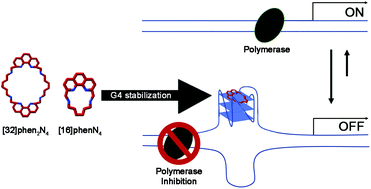当前位置:
X-MOL 学术
›
Org. Biomol. Chem.
›
论文详情
Our official English website, www.x-mol.net, welcomes your feedback! (Note: you will need to create a separate account there.)
Phenanthroline polyazamacrocycles as G-quadruplex DNA binders†
Organic & Biomolecular Chemistry ( IF 3.2 ) Pub Date : 2018-03-21 00:00:00 , DOI: 10.1039/c8ob00247a Josué Carvalho 1, 2, 3, 4 , Telma Quintela 1, 2, 3, 4 , Nassima M. Gueddouda 5, 6, 7, 8, 9 , Anne Bourdoncle 5, 6, 7, 8, 9 , Jean-Louis Mergny 5, 6, 7, 8, 9 , Gilmar F. Salgado 5, 6, 7, 8, 9 , João A. Queiroz 1, 2, 3, 4 , Carla Cruz 1, 2, 3, 4
Organic & Biomolecular Chemistry ( IF 3.2 ) Pub Date : 2018-03-21 00:00:00 , DOI: 10.1039/c8ob00247a Josué Carvalho 1, 2, 3, 4 , Telma Quintela 1, 2, 3, 4 , Nassima M. Gueddouda 5, 6, 7, 8, 9 , Anne Bourdoncle 5, 6, 7, 8, 9 , Jean-Louis Mergny 5, 6, 7, 8, 9 , Gilmar F. Salgado 5, 6, 7, 8, 9 , João A. Queiroz 1, 2, 3, 4 , Carla Cruz 1, 2, 3, 4
Affiliation

|
Targeting quadruplex DNA structures with small molecules is a promising strategy for anti-cancer drug design. Four phenanthroline polyazamacrocycles were studied for their binding affinity, thermal stabilization, inhibitory effect on the activity of helicase towards human telomeric 22AG and oncogene promoter c-MYC G-quadruplexes (G4s), and their ability to inhibit Taq polymerase-mediated DNA extension. The fluorescence resonance energy transfer (FRET) melting assay indicates that the melting temperature increases (ΔTm values) of c-MYC and 22AG G4s are 17.2 and 20.3 °C, respectively, for the ligand [32]phen2N4 followed by [16]phenN4 (11.3 and 15.0 °C, for c-MYC and 22AG, respectively). Competitive FRET assays show that [32]phen2N4 and [16]phenN4 exhibit G4 selectivity over duplex DNA. Different G4s were compared; no considerable selectivity of the ligands for a specific G4 was found. Circular dichroism (CD) confirms the formation of G4 structures and the melting experiments show that [16]phenN4 and [32]phen2N4 are the most stabilizing ligands with a ΔTm of 19.3 °C and 15.1 °C, respectively, at 5 molar equivalents for the c-MYC G4. The fluorescent intercalator displacement (FID) assay also demonstrates that ligand [32]phen2N4 furnishes very low DC50 values (0.87–1.24 μM), indicating high stabilization of c-MYC and 22AG G4s. These results suggest that the hexyl chain in these compounds plays an important role in regulating the stabilization of these G4s. Binding constants, determined by fluorescence titrations, indicate a moderate ligand–G4 binding with KSV between 105 and 106 M−1 in which [16]phenN4 has a slightly higher apparent binding constant for telomeric 22AG G4 than that for the c-MYC G4. The ligand's ability to inhibit Taq polymerase confirms the biological activity of [16]phenN4 and [32]phen2N4 against the c-MYC G4. In addition, ligands [32]phen2N4 and [16]phenN4 affect the unwinding activity of Pif1 in the presence of DNA systems harboring c-MYC and telomeric G4 motifs.
中文翻译:

菲咯啉聚氮杂大环化合物作为G-四链体DNA结合物†
用小分子靶向四链体DNA结构是抗癌药物设计的一种有前途的策略。研究了四个菲咯啉聚氮杂大环化合物的结合亲和力,热稳定性,对解旋酶对人端粒22AG和癌基因启动子c-MYC G-四链体(G4s)的抑制作用以及它们抑制Taq聚合酶介导的DNA延伸的能力。荧光共振能量转移(FRET)熔解测定表明,对于配体[32] phen 2 N 4,c-MYC和22AG G4s的熔解温度升高(ΔT m值)分别为17.2和20.3°C 。 [16] phenN 4(对于c-MYC和22AG分别为11.3和15.0°C)。竞争性FRET分析表明[32] phen 2 N 4和[16] phenN 4相对于双链DNA表现出G4选择性。比较了不同的G4。没有发现配体对特定G4的显着选择性。圆二色性(CD)证实了G4结构的形成,熔融实验表明[16] phenN 4和[32] phen 2 N 4是最稳定的配体,ΔT m分别为19.3°C和15.1°C。对于c-MYC G4,为5摩尔当量。荧光嵌入剂置换(FID)分析还表明,配体[32] phen 2 N 4提供非常低的DC 50值(0.87-1.24μM),表明c-MYC和22AG G4具有很高的稳定性。这些结果表明,这些化合物中的己基链在调节这些G4的稳定性中起重要作用。通过荧光滴定确定的结合常数表明,中等配体–G4与K SV的结合在105和10 6 M -1之间,其中[16] phenN 4对端粒22AG G4的表观结合常数略高于c- MYC G4。配体抑制Taq聚合酶的能力证实了[16] phenN 4和[32] phen 2 N 4的生物活性。对抗c-MYC G4。另外,在具有c-MYC和端粒G4基序的DNA系统存在下,配体[32] phen 2 N 4和[16] phenN 4影响Pif1的解链活性。
更新日期:2018-03-21
中文翻译:

菲咯啉聚氮杂大环化合物作为G-四链体DNA结合物†
用小分子靶向四链体DNA结构是抗癌药物设计的一种有前途的策略。研究了四个菲咯啉聚氮杂大环化合物的结合亲和力,热稳定性,对解旋酶对人端粒22AG和癌基因启动子c-MYC G-四链体(G4s)的抑制作用以及它们抑制Taq聚合酶介导的DNA延伸的能力。荧光共振能量转移(FRET)熔解测定表明,对于配体[32] phen 2 N 4,c-MYC和22AG G4s的熔解温度升高(ΔT m值)分别为17.2和20.3°C 。 [16] phenN 4(对于c-MYC和22AG分别为11.3和15.0°C)。竞争性FRET分析表明[32] phen 2 N 4和[16] phenN 4相对于双链DNA表现出G4选择性。比较了不同的G4。没有发现配体对特定G4的显着选择性。圆二色性(CD)证实了G4结构的形成,熔融实验表明[16] phenN 4和[32] phen 2 N 4是最稳定的配体,ΔT m分别为19.3°C和15.1°C。对于c-MYC G4,为5摩尔当量。荧光嵌入剂置换(FID)分析还表明,配体[32] phen 2 N 4提供非常低的DC 50值(0.87-1.24μM),表明c-MYC和22AG G4具有很高的稳定性。这些结果表明,这些化合物中的己基链在调节这些G4的稳定性中起重要作用。通过荧光滴定确定的结合常数表明,中等配体–G4与K SV的结合在105和10 6 M -1之间,其中[16] phenN 4对端粒22AG G4的表观结合常数略高于c- MYC G4。配体抑制Taq聚合酶的能力证实了[16] phenN 4和[32] phen 2 N 4的生物活性。对抗c-MYC G4。另外,在具有c-MYC和端粒G4基序的DNA系统存在下,配体[32] phen 2 N 4和[16] phenN 4影响Pif1的解链活性。


























 京公网安备 11010802027423号
京公网安备 11010802027423号